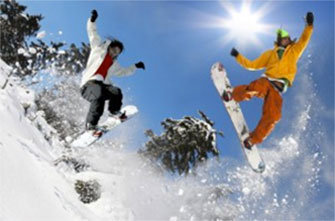
But along with those thrills often comes the chance of spills, some of which can have serious consequences. Just ask Patrick Ferris.
‘It was a freak accident’
During the winter of 2006, Patrick was just another teen having good times with friends.
Like nearly 10 million fellow ski and snowboard enthusiasts in the United States, Patrick looked forward to hitting the slopes every year.
While vacationing in northern Michigan with his family and a friend, an afternoon on the slopes, however, quickly turned disastrous.
Patrick was mid-run on his snowboard when he collided with a rope barrier on the side of the hill. The rope hit Patrick’s throat and crushed his windpipe. He gasped for air.
His friend rushed to alert patrol staff of the seriousness of the incident. After being stabilized at a local hospital, Patrick was flown to Helen DeVos Children’s Hospital. He underwent six hours of surgery as doctors worked to repair his windpipe.
Injuries – although many are not as severe as Patrick’s – are a part of snowboarding and skiing. The National Ski Areas Association reports 6.1 injuries per 1,000 daily ski/snowboard visits and 44 fatalities in the past decade.
In Patrick’s case, it would be months before his health was restored. The only lingering evidence of the incident is a soft voice due to paralyzed vocal cords.
Today, Patrick is a 19-year-old sophomore at the University of Michigan, majoring in mechanical engineering.
“Yes, I still snowboard,” Patrick says. “I never once thought I’d never get on a snowboard again. I wasn’t scared, either, but I think my mom might have been.”
He adds, “I didn’t get hurt trying some trick or flip. It was a freak accident. …If I had to give some advice, I would just say, ‘Be smart. As fun as it is, snowboarding and skiing are dangerous sports. Don’t put yourself in unnecessary danger. And always wear a helmet.’”
When winter sports hurt
Even helmets can’t prevent all injuries. The physical demands of winter sports can result in pain even without an accident. Then what? Nathan Cekander knows.
Nathan was 14 and passionate about hockey.
To stay in the game, he kept quiet about persistent hip pain. Although his mom sought medical help, tests and imaging studies led them in many directions, including several rounds of physical therapy. The therapy would temporarily improve Nathan’s pain, but he says, “it always came back.”
At one point he was told it could be arthritis, although this diagnosis seemed unusual in someone so young.
His mom, Carolyn Cekander, wasn’t about to give up. She took him to Stephen McMahon, MD, a pediatrician with Spectrum Health Medical Group.
Dr. McMahon agreed that arthritis just didn’t seem to fit the bill. He referred the Cekanders to Olusanjo Adeoye, MD, an orthopaedic surgeon with Spectrum Health Medical Group Sports Medicine.
Dr. Adeoye’s expertise was particularly validating for Nathan, who, after so long, had wondered if he was imagining his symptoms. Diagnosed with a hip labral tear and a complex impingement, Dr. Adeoye recommended surgery to repair the hip. Before the surgery, however, Nate was able to receive treatment that allowed him to finish his hockey season – and pay respects to a fallen teammate.
Nathan is in good company. Ice sports result in their fair share of injuries each year. In 2012, the Consumer Product Safety Commission tallied more than 20,000 incidents of bone fractures and 248,418 emergency department visits from ice sports alone.
Tips for the best winter yet
The key to safely enjoying the snow and ice comes down to understanding the risks, wearing protective gear, and getting specialized treatment when injuries do occur.
Whether it’s related to your winter sport or everyday life, don’t give up. And if your gut instinct is that a diagnosis may not be accurate, get a second opinion. Now 18, Nathan’s glad he did. He can again play hockey without pain.
In the end, winter sports carry risks not so different than those that come with any sport or physical pursuit.
Matthew Axtman, DO, a sports medicine physician with Spectrum Health Medical Group, says that children ages 5 to 14 are the most likely to suffer winter sports injuries.
Dr. Axtman offers nine smart moves to keep you and your children safe and sensational until the last snowfall of the season.
- Always wear protective gear for your sport, every time, all the time. This includes helmets and goggles.
- Don’t sled down hills near traffic.
- Don’t sled on your stomach or try to stand. Sit up.
- Only take on the next degree of difficulty when your skills say you’re ready, whatever your sport.
- Always snowboard, ski or skate with a buddy.
- If an accident happens that looks serious, get professional help as quickly as possible.
- When pain persists, don’t hide it; see a doctor.
- If joint or muscle pain persists for 48 hours, see a doctor.
- If you hit your head and develop a headache, confusion or sensitivity to light, see a doctor immediately.
 /a>
/a>
 /a>
/a>
 /a>
/a>